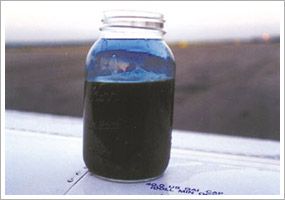| The following stories from the October 3, 2008, edition of AOPA ePilot were provided to AOPA members who expressed an interest in the particular subject areas. Any AOPA member can receive information tailored to their areas of interest by updating their preferences online. TRAINING TIPsPurging fuel contaminants Usually your fuel test will come back negative. But what do you do if a cupful of water comes out in your fuel sample? Can you remove all of the contaminant? How did it get in there in the first place? Your POH, in the section on service and maintenance, describes the proper way to remove contaminants, and when it may be advisable to postpone flying and turn the problem over to the folks who look after your aircraft. Know the section's contents. Also review the AOPA Air Safety Foundation's Safety Advisor, Fuel Awareness . One of its helpful tips is to delay taking a fuel sample for a few minutes after refueling to let any water settle. Also, test your understanding of fuel contamination against questions 19 and 20 from this list of sample questions from the light sport pilot knowledge test. Additional guidance is found in FAA Advisory Circular (AC) Water in Aviation Fuels . Note recommendations for pilots of tailwheel aircraft, aircraft with cross-feed fuel systems, and those with wing-mounted fuel tanks. The AC's most vital advice, however, is the recommendation that if there's any doubt whether contaminants are present, turn the aircraft over to the experts for further examination. TRAINING PRODUCTSPortable laser flare can signal for help Here's a new addition for your off-airport survival kit: a rescue laser light. The handheld signaling device is not a pyrotechnic flare and can be carried aboard an aircraft. Its visibility range is up to 20 miles at night or one to three miles during the day. It operates 40 hours on a three-volt lithium battery and weighs three ounces. The Rescue Laser Flare sells for $89.99 and is available at Pilotmall.com. Note: Products listed have not been evaluated by ePilot editors unless otherwise noted. AOPA assumes no responsibility for products or services listed or for claims or actions by manufacturers or vendors. FINAL EXAMQuestion: What are land and hold short operations? Answer: Land and hold short operations (LAHSO) allow greater capacity and efficiency at certain towered airports through the simultaneous use of intersecting or nearby runways or taxiways. These airports and their available landing distances are listed in the Airport/Facility Directory. The controller may clear you to land and hold short of a specified point on the runway. The pilot in command has the final authority to accept or decline such a clearance and must be familiar with the available landing distances prior to acceptance. The PIC must also take into consideration temperature, wind, elevation, speed, and runway surface conditions when calculating the landing distance needed. If a LAHSO clearance is accepted, it must be read back to the controller in full ( AIM 4-3-11). Note that although LAHSO is a special emphasis area for flight examiners to cover on the private pilot practical test, student pilots or pilots not familiar with LAHSO should not participate. Read more in this publication from the AOPA Air Safety Foundation. Got a question for our technical services staff? E-mail to [email protected] or call the Pilot Information Center, 800/872-2672. Don't forget the online archive of "Final Exam" questions and answers, searchable by keyword or topic. |
 When you learned to preflight an aircraft, your instructor stressed the
When you learned to preflight an aircraft, your instructor stressed the 